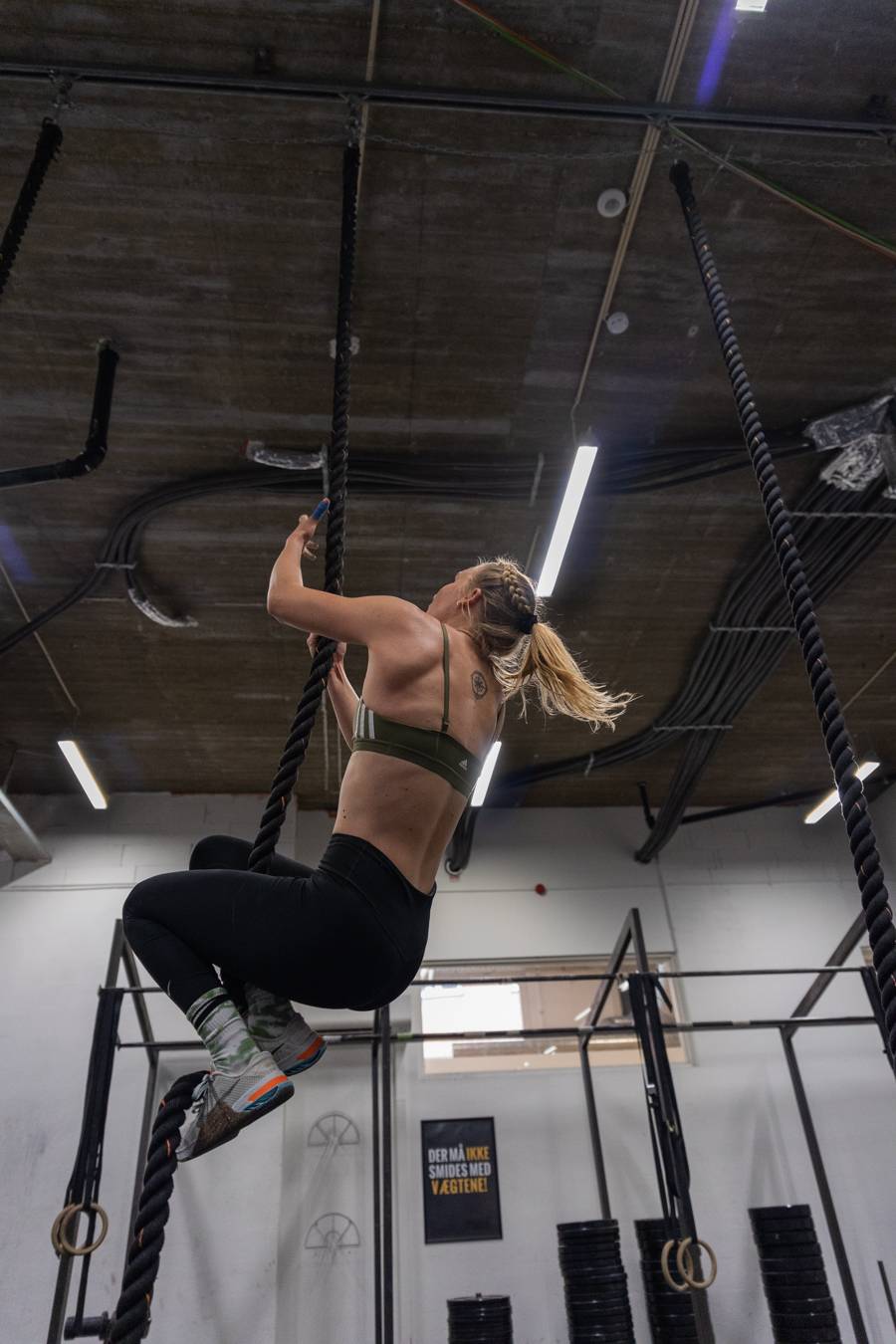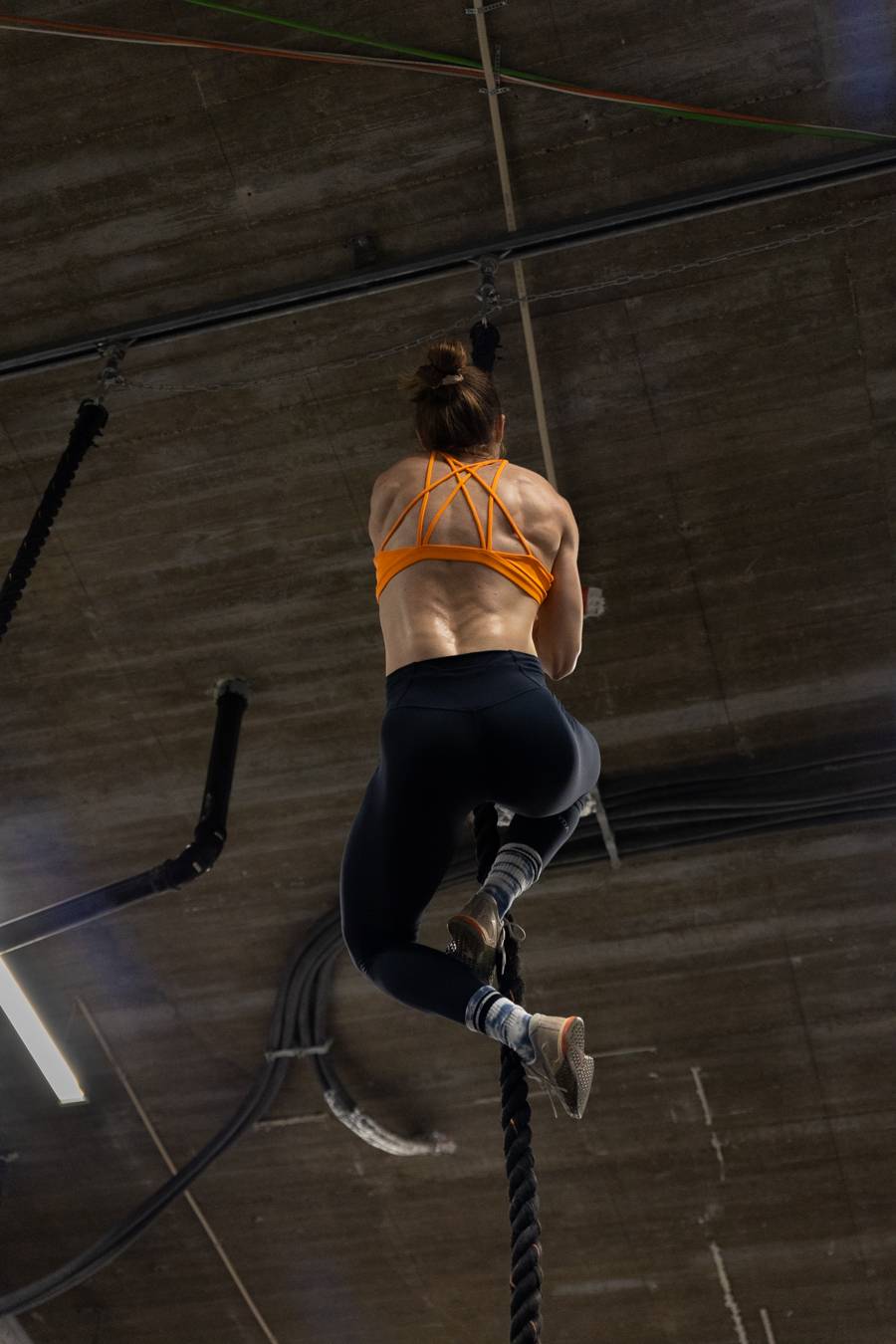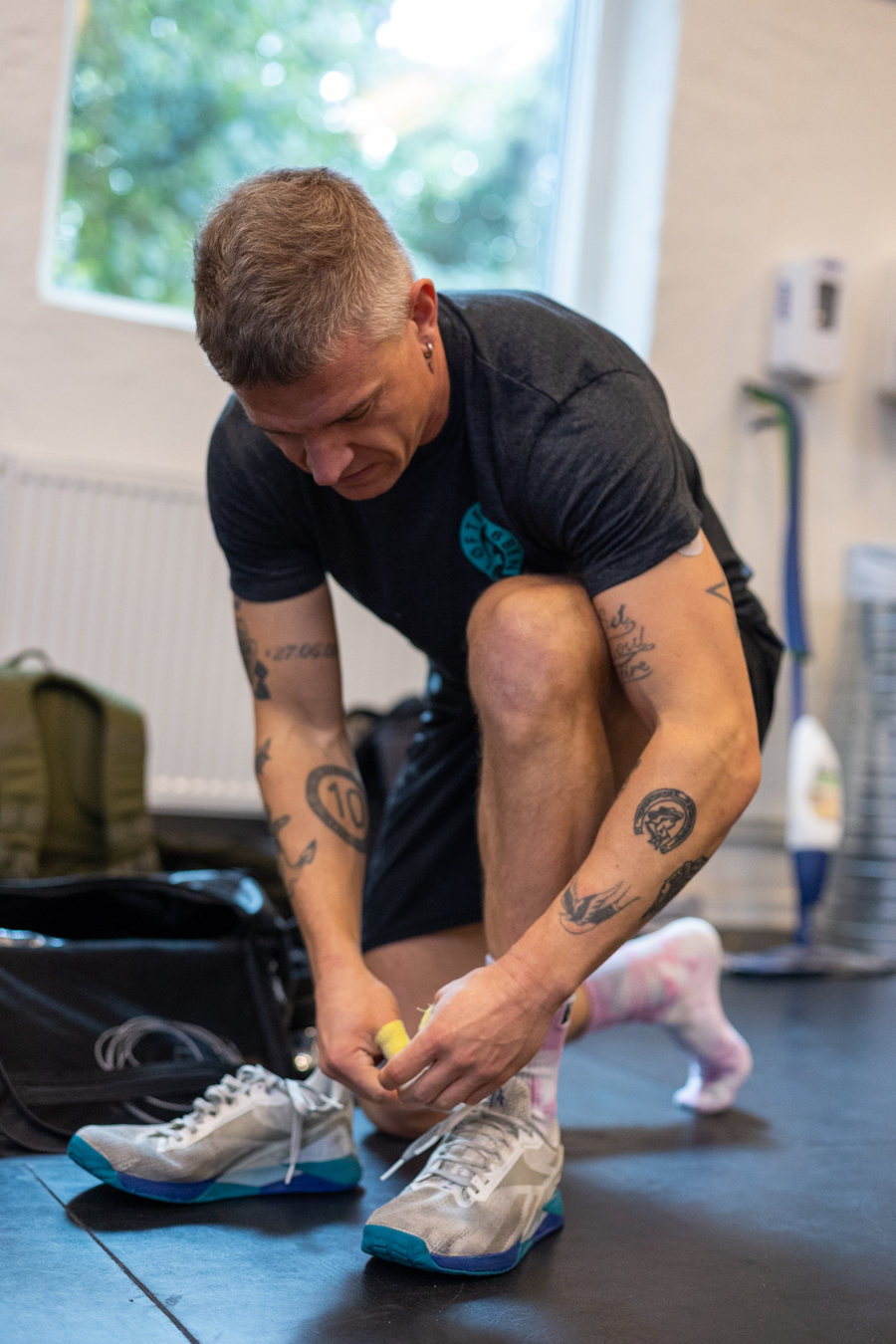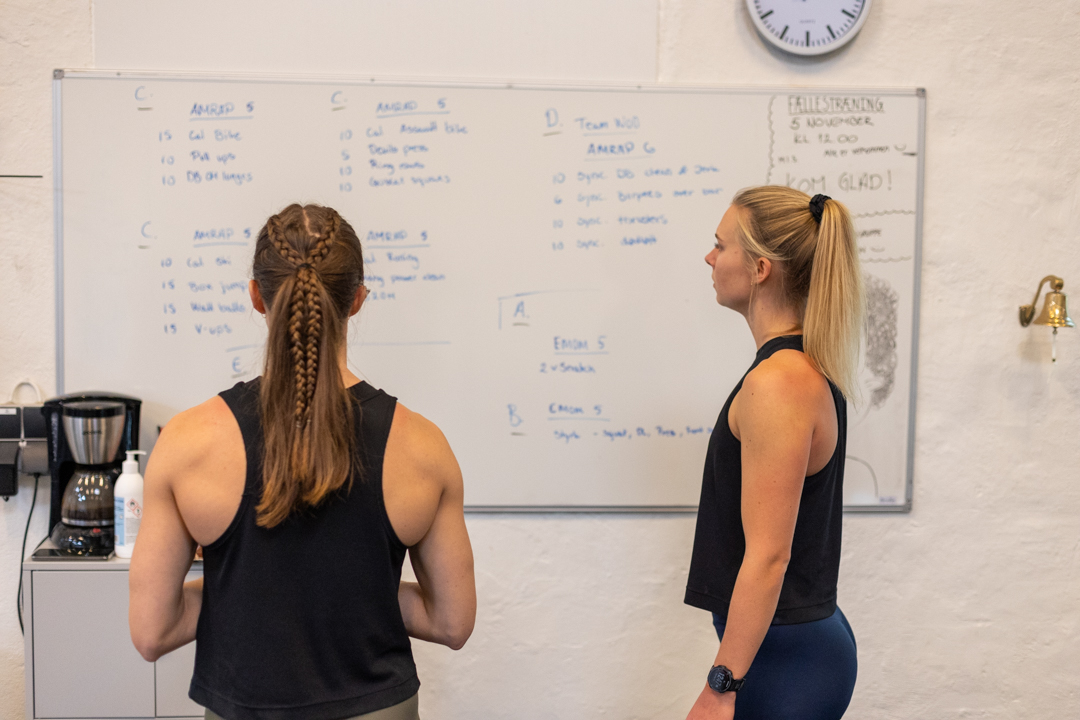Newest programs
Popular posts
Information
Who are we?
MuscleFit Program is a fitness plan created by experienced coaches with science and health backgrounds. It focuses on strength, weightlifting, gymnastics, and conditioning.
contact us

Hey there, future Crossfit warriors!
Ready to scale new heights and master the art of rope climbing? Whether you're just dipping your toes into the exhilarating world of Crossfit or looking to conquer one of its most iconic challenges, you've come to the right place. In this guide, we'll walk you through everything you need to know about how to climb a rope without breaking a sweat (okay, maybe a little sweat). Rope climbing might seem daunting at first, but with the right tips and techniques, you'll be shimmying up that rope like a pro in no time!
So, grab your gym gear, and let's dive into the thrilling and gravity-defying world of climbing ropes and rope climbing. Ready, set, climb!
Rope climbing is more than just a flashy skill to show off at the gym; it’s a fundamental exercise that builds core strength, enhances grip, and improves overall athleticism. Understanding how to climb a rope can set you apart in your Crossfit journey, pushing your limits and boosting your confidence. Picture this: you're in the middle of an intense WOD (Workout of the Day), and the next challenge is a rope climb. By mastering climbing ropes, you seamlessly incorporate upper body strength, coordination, and mental fortitude into one dynamic move, leaving your workout partners in awe.
But why stop at the basics? Rope climbing engages multiple muscle groups including your biceps, back, abs, and legs, providing an all-encompassing workout that can’t be matched by traditional weightlifting alone. It’s also a fantastic cardiovascular exercise. As your heart rate spikes while you ascend, you're not only building muscle but torching calories. Plus, the technique and strategic thinking involved in rope climbing can be a refreshing change from your usual workouts, adding variety to your routine and keeping things exciting.
So, why is rope climbing essential for Crossfit enthusiasts? Because it challenges you to break through barriers, enhances your physical capabilities, and integrates seamlessly into the diverse and high-intensity spirit of Crossfit. Get ready to conquer that rope and take your fitness to the next level!

Before you jump into the exhilarating challenge of learning how to climb a rope, let’s talk about the essential gear you’ll need to get started. First and foremost, you’ll need a high-quality climbing rope. Not all ropes are created equal, so make sure to choose one that is durable and specifically designed for fitness and rope climbing. Look for ropes made from manila or poly dacron, as these materials offer excellent grip and long-lasting performance.
Next up, proper footwear is a must. You'll need shoes with a solid grip to prevent slipping as you ascend. Some athletes prefer minimalist shoes while others opt for something with a bit more structure—find what works best for you through trial and error.
Don't forget about your hands! Climbing ropes can be tough on your palms, so investing in a good pair of climbing gloves or applying chalk can make a world of difference. These will help improve your grip and reduce the risk of blisters.
Lastly, wearing appropriate workout attire is crucial. Opt for flexible, moisture-wicking clothing that won't restrict your movement and will keep you comfortable during your rope climbing sessions. A supportive pair of knee pads can also be beneficial, especially if you're practicing your technique on a rougher surface.
So, gear up with the right equipment and you'll be well on your way to mastering how to climb a rope. Not only will you enhance your climbing experience, but you'll also ensure a safer and more enjoyable journey to the top. Now, let’s get climbing and make those Crossfit dreams a reality!
Understanding the different types of ropes available can significantly impact your success in rope climbing, especially if you're keen on mastering how to climb a rope. Not all ropes are created equal, and selecting the right one can make your climbing experience smoother and more enjoyable.
These are the classic, go-to choice for many Crossfitters. Made from natural fibers, manila ropes offer excellent grip and durability, making them ideal for intense rope climbing sessions.
Which are perfect if you're looking for something with reduced friction. Polyester ropes are generally smoother and less abrasive on the hands, making them a great option for beginners learning the art of climbing rope.
Known for its elasticity and strength, nylon is often used in dynamic rope climbing situations where a bit of stretch can help absorb impacts and reduce strain on the body. This type of rope is also highly resistant to abrasion, ensuring it withstands rigorous use.
Combining various materials to bring you the best of both worlds – durability and a comfortable grip. These ropes are versatile and can be used for various types of rope climbing exercises.
Each type of rope offers unique benefits, so choosing the right one depends on your climbing style, fitness goals, and personal preference. Whether you're just starting out or looking to step up your Crossfit game, knowing the ins and outs of these ropes can help you tailor your training to get the most out of your rope climbing workouts. So, get your hands on the right climbing rope and watch as you scale new heights in your fitness journey!

Choosing the right shoes and gloves is crucial when it comes to mastering how to climb a rope effectively and safely. For shoes, grip is paramount. Look for footwear with a strong, sticky rubber sole that can latch onto the rope, giving you the traction needed to propel yourself upward. Running shoes often fall short in this department, so consider investing in specialized climbing or Crossfit shoes. Minimalist shoes are popular among some climbers for their lightweight and flexible nature, allowing for better foot positioning on the rope. Others might prefer shoes with added support and structure to protect against rope burns and enhance stability.
When it comes to gloves, a good grip and hand protection are essential. Climbing ropes can be tough on your hands, so finding a pair of gloves that provide a sturdy grip without sacrificing comfort is key. Look for gloves with a textured palm and finger area, often made from materials like leather or silicone, to ensure you can firmly grasp the rope. Some athletes prefer fingerless gloves for better finger dexterity, while others opt for full-finger gloves to protect their entire hand from friction and potential rope burns.
If gloves aren’t your style, chalk can be a fantastic alternative. By absorbing sweat and providing a better grip, chalk can help you ascend the climbing rope more efficiently. Just be sure to reapply as necessary to maintain that critical grip.
Ultimately, the best shoes and gloves for rope climbing boil down to personal preference and comfort. Experiment with different options to find the perfect combination that helps you tackle rope climbing challenges like a pro. Gear up, grip tight, and get ready to conquer that next big Crossfit WOD with confidence and flair!

Ready to tackle one of Crossfit’s most iconic challenges? Here's your step-by-step guide on how to climb a rope, filled with essential tips and techniques to get you started on your rope climbing journey.
The first crucial step in learning how to climb a rope is mastering the grip. You’ll want to start with a solid hand-over-hand grip. Reach up as high as you can with your dominant hand, gripping the rope tightly. Your non-dominant hand should follow, gripping just below. This staggered grip will help you ascend efficiently and safely.
Foot positioning is key in rope climbing, providing stability and power. There are a couple of popular techniques, such as the J-hook and the S-wrap. For the J-hook, bring your dominant foot up and hook the rope. Next, press your non-dominant foot against the rope, creating a secure lock between your feet, which enables you to push up. For the S-wrap, twist the rope around one leg and clamp down with the opposite foot for a secure hold.
With your hands gripping the rope and feet securely locked, it’s time to make your move. Begin by pulling yourself upward with your arms as you simultaneously push with your legs. This combined action helps you ascend smoothly without over-relying on just one muscle group.
Continue to alternate your hand grips while pressing upward with your feet. Keep your core engaged to maintain balance and stability. With each movement, think about climbing in small, controlled increments rather than trying to leap up the rope. This method keeps your ascent steady and efficient, minimizing the risk of slipping.
Once you’ve reached the top, your job isn’t done yet! Descending the rope safely is just as important. Carefully slide your hands down while maintaining a secure grip and keeping your feet locked for control. Move slowly, using the same alternating hand-over-hand technique you used to climb up.
1. Pace Yourself: Start slow and focus on perfecting your technique before attempting speed.
2. Stay Consistent: Regular practice is key to improving your climbing ability. Incorporate rope climbing into your weekly workout routine.
3. Strength Training: Enhance your upper body strength with exercises like pull-ups and rows to improve your climbing performance.
4. Core Workouts: Strengthen your core with planks and leg raises to achieve better balance and stability on the rope.
So there you have it! Follow these steps and you'll be climbing ropes like a seasoned Crossfit athlete in no time. Remember, patience and consistency are your best friends when mastering how to climb a rope. Now get out there, conquer that rope, and take your Crossfit game to new heights!

Now, let’s talk about one of the most effective methods for ascending the rope: the S-Hook technique. When learning how to climb a rope, mastering the S-Hook can transform this seemingly Herculean task into a manageable and even enjoyable challenge. The S-Hook technique involves wrapping the rope around one leg and securing it with the opposite foot, creating a stable platform to push off from and helping you inch your way up the rope with control and confidence.
To start, extend one leg and loop the rope around it, bringing the rope across your shin and under your foot. With your other foot, press down on the rope against your shin, creating an ""S"" shape. This grip allows you to ""stand"" on the rope, giving your upper body a chance to rest as you push yourself upward.
While climbing ropes, keep your body in a slightly leaned-back position to maintain balance and leverage. Use your legs to bear the brunt of the task, conserving your upper body strength for longer climbs. Remember to keep your movements smooth and controlled to avoid unnecessary swings or slips.
Practicing the S-Hook technique might feel awkward at first, but with consistent effort, it will become second nature. The balance and coordination required in this method can also enhance your overall agility and athletic prowess.
So, embrace the S-Hook technique—it’s your secret weapon for mastering how to climb a rope effectively. Practice regularly, and soon you'll find yourself scaling ropes with the confidence and skill of a seasoned Crossfit athlete. Get a grip (literally!), and let’s conquer those ropes together!
When it comes to mastering how to climb a rope, perfecting essential body movements can make all the difference in your rope climbing efficiency and success. These movements not only enhance your technique but also help in conserving energy as you ascend.
First and foremost, let's talk about the pulling motion. Your arms and shoulders are your main engines for pulling yourself up the rope. Engage your lats and biceps as you pull, making sure to keep your elbows close to your body to maximize strength and minimize fatigue. A hand-over-hand grip works best, providing stability and control as you climb.
Next up is the importance of core engagement. Your core is the powerhouse that keeps your body stable and aligned as you climb. Tightening your core helps avoid unnecessary swinging and maintains your center of gravity, making each pull smoother and more efficient. Exercises like planks and leg raises can enhance your core strength, directly benefiting your rope climbing capability.
Your legs also play a crucial role in rope climbing. Techniques like the J-hook or the S-wrap, as previously discussed, are essential for locking your feet onto the rope, giving you a stable platform to push off from. Your legs should do a lot of the heavy lifting to save your upper body strength for the climb.
Also, don’t forget the hip thrust. By driving your hips upwards as you pull with your arms and push with your legs, you create a fluid, coordinated movement that propels you up the rope more effectively. This motion not only helps in climbing but also boosts your overall body coordination and power.
Last but certainly not least, breathing is vital. Consistent and controlled breathing can prevent unnecessary tension and improve your stamina. Take deep, steady breaths to maintain oxygen flow to your muscles, helping you stay focused and energized throughout your climb.
Incorporating these essential body movements can transform your rope climbing experience, making it not just a test of strength but a demonstration of skill and efficiency. Remember, practice makes perfect, so integrate these movements into your training routine, and soon you'll be climbing ropes with grace and ease.
So gear up, focus on these key body movements, and get ready to elevate your rope climbing game to new heights!

Whether you're just starting to learn how to climb a rope or looking to refine your existing technique, there are several common mistakes that can trip you up and slow your progress. By identifying and avoiding these pitfalls, you'll be well on your way to becoming a rope climbing pro, impressing your Crossfit buddies and smashing those WODs with flair.
Neglecting Proper Form: One of the biggest mistakes is overlooking the importance of proper form. Sloppy technique not only makes climbing more difficult but can also lead to injury. Focus on employing the correct hand grips, foot locks, and body positioning to climb efficiently and safely.
Relying Solely on Upper Body Strength: Many beginners make the mistake of using just their arms to pull themselves up the rope. This can quickly lead to fatigue and a stalled climb. Remember, your legs are powerhouses! Utilize them with techniques like the J-hook or S-wrap to distribute the workload and conserve energy.
Overgripping and Tensing Up: It's natural to grip the rope tightly, but overgripping can actually tire you out faster. Maintain a firm, but relaxed grip to prevent unnecessary tension in your muscles. Similarly, try to stay relaxed and avoid tensing your entire body—it'll save you a lot of energy.
Skipping Warm-Ups and Core Work: Jumping straight into rope climbing without a proper warm-up can be disastrous. Engage in dynamic stretches and light cardio to get your muscles ready. Additionally, ignoring core workouts can hamper your balance and stability on the rope. Incorporate planks, leg raises, and other core exercises into your training routine.
Inconsistent Practice: Perhaps the most common mistake is not practicing regularly. Consistency is key in learning how to climb a rope. Integrate rope climbing drills into your weekly workouts to build muscle memory and enhance your climbing prowess over time.
Ignoring Footwear and Grip Aids: Don’t overlook the importance of wearing the right shoes and using grip aids like chalk or gloves. Improper footwear can lead to slips, while bare hands can become a painful liability. Choose gear that provides a solid grip and protects your skin from blisters and burns.
Rushing the Climb: Speed will come with practice; prioritize technique over speed. Rushing often leads to poor form and wasted energy. Take your time to master each phase of the climb, and the speed will naturally follow.
Avoid these common mistakes, and you’ll find that your rope climbing skills improve dramatically. By focusing on proper form, leveraging your whole body, and practicing consistently, you’ll not only master the art of climbing rope but also enhance your overall Crossfit game. So, climb on, and let’s reach new heights together!

As exciting as rope climbing can be, safety should always be your top priority. Here are some essential safety tips to ensure that your journey to mastering how to climb a rope is not only fun but also injury-free.
Warm Up Thoroughly: Before you even think about grabbing that rope, engage in a comprehensive warm-up. Focus on dynamic stretches that loosen up your shoulders, arms, and legs. A good warm-up will prepare your muscles for the intense activity ahead, reducing the risk of strains and injuries.
Check Your Equipment: Always inspect your climbing rope for any signs of wear and tear. A frayed or damaged rope can be dangerous. Make sure it's securely anchored to a stable point. Also, ensure that your shoes and gloves are in good condition to provide the necessary grip and support.
Use Proper Technique: Rope climbing isn’t just about brute strength; technique is crucial. Employing the right hand grips, foot locks, and body positioning can make all the difference. The J-hook and S-wrap techniques are highly recommended for securing your feet on the rope, allowing you to climb efficiently and safely.
Start Slowly: If you're new to climbing ropes, don't rush. Start with shorter climbs and gradually increase the height as you build strength and confidence. Trying to conquer a tall rope too soon can lead to exhaustion or an unplanned fall.
Stay Focused: Concentrate on your movements and stay aware of your surroundings. Distractions can lead to mistakes, so keep your eyes on the prize (or in this case, the rope) and ensure each hand and foot placement is secure before moving on.
Descend with Caution: Climbing down can be just as challenging as climbing up. Use a controlled, hand-over-hand technique to descend slowly. Maintain your foot locks and keep a firm grip to avoid slipping.
Listen to Your Body: If you feel any unusual pain or discomfort, stop immediately. Pushing through pain can lead to serious injury. Take a break, assess the situation, and seek advice if necessary.
Buddy System: Whenever possible, rope climb with a partner. Having someone spot you can provide an added layer of safety and boost your confidence. Plus, it’s always more fun to share the experience with a friend!
Hydrate: Don't forget to drink water before and after your climb. Staying hydrated is essential for maintaining energy levels and muscle function.
By following these safety tips, you’ll not only enhance your rope climbing skills but also ensure that your workouts are both fun and injury-free. So gear up, stay safe, and let's conquer those ropes like the Crossfit champions we aspire to be!

Once you’ve got the basics down and feel confident in your climbing abilities, it’s time to seamlessly incorporate rope climbing into your Crossfit routine. Learning how to climb a rope is just the beginning; optimizing your workouts with this dynamic exercise can take your fitness game to the next level.
Start with a general warm-up that gets your blood pumping and muscles ready. Incorporate specific movements like arm circles, shoulder stretches, and leg swings to prepare the key muscle groups you’ll be using for rope climbing. Don’t rush through this—warming up is crucial to prevent injuries and improve overall performance.
Dedicate a portion of your workout to practicing rope climbing techniques. Start with simple drills focusing on your grip, foot locks, and body positioning. Gradually increase the complexity and intensity, perhaps aiming for a few controlled climbs up and down the rope. This skill practice should be tailored to your current ability level, gradually pushing you to improve.
Rope climbing is an excellent full-body workout, but incorporating complementary strength exercises can enhance your climbing efficiency. Focus on movements like pull-ups, rows, and farmer’s carries to build upper body strength. Don’t forget core exercises like planks, hanging leg raises, and Russian twists to develop the stability you need for efficient climbiing.
Add rope climbing to your Crossfit circuits for an extra challenge. For example, a circuit could include a combination of rope climbs, burpees, kettlebell swings, and box jumps. Mixing rope climbs with other high-intensity exercises keeps your workouts varied and prevents boredom while building functional strength and endurance.
Many Crossfit WODs (Workouts of the Day) naturally incorporate rope climbs. Tailor these WODs to your fitness level by adjusting the number of climbs or adding scaling options like partial climbs or towel pulls. As you become more proficient, you can increase the intensity and complexity of these WODs.
Finish your workout with a structured cool-down, including stretching and mobility exercises. Pay special attention to the muscles worked during your rope climbs—your shoulders, back, arms, and legs. Stretching and foam rolling can help reduce muscle soreness and improve your flexibility, aiding your recovery.
Keep a log of your rope climbing progress. Note the number of climbs, techniques used, and any scaling or modifications. Tracking your progress helps you stay motivated and see how far you’ve come, as well as identify areas where you might need to focus more attention.
Incorporating rope climbing into your Crossfit routine isn’t just about mastering how to climb a rope—it’s about making this exciting, full-body exercise a staple in your fitness regimen. With consistency and a well-rounded approach, you’ll not only improve your rope climbing skills but also enhance your overall athletic performance. So grab that rope, get climbing, and watch as your Crossfit prowess reaches new heights!
Front Squat vs Back Squat: Key Differences and Which is Better?
What Is an Air Squat?
Calisthenics for Beginners: Start Your Fitness Journey
What is a Tabata Workout?
How Many Sit Ups Should I Do a Day? Discover the Benefits for CrossFit
10 Crossfit Core Exercises for Building a Strong Core
The Ultimate CrossFit Diet Plan: Maximize Your Performance
Reverse Plank Hold: The Ultimate Guide for CrossFit